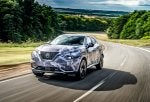Ahead of that car's official unveiling in early September, Autocar joined Nissan for a preview of a disguised pre-production model, including a brief stint behind the wheel.
![]()
The aim was simple: keep the sense of fun and sportiness that drew in existing buyers, but smooth off the sharper edges and annoyances, such as limited rear seat and boot space.
The new Juke uses the Renault-Nissan-Mitsubishi Alliance's Common Module Family B (CMF-B) platform. This platform also underpins the new Renault Captur and Clio and brings several benefits. For a start, the Juke's footprint is still a reasonable 4210mm (up 75mm) but the wheelbase has grown by 106mm to 2636mm. That's 85mm up on a Volkswagen T-Cross, allowing for one of the roomier cabins in its class.
Nissan wouldn't confirm that a plug-in hybrid is on the cards. But a Captur PHEV has already been announced, so it's a strong likelihood. A fully electric version is less of a given.
The secondary ride is less jittery over smaller imperfections, but the primary one still feels a bit abrasive over sharper ridges. That said, our car was on 19in wheels, and apparently on 17in rims, with bigger sidewalls and redefined spring and damper settings, it's much smoother. The suspension has been signed off, though, so fingers crossed.
The steering is much more fluent now. It's light but weights progressively and, paired with tight body control, that should bode well for relatively dexterous handling.
As for performance, the 1.0-litre three-pot feels perky enough to match the unit of identical output in the VW T-Cross. Bearing in mind there's still a bit of tuning left to do to the throttle response, it accelerates in a linear fashion. The fundamental difference between this installation and the Micra's is the availability of 15lb ft of torque overboost in all six gears. The Micra has it in the first five ratios only.
The engine is a tad grumbly at idle and the seven-speed dual-clutch auto (yes, the old CVT has been ditched) introduces more resonance on the move than the six-speed manual gearbox. Both issues have been flagged up with the development team.
On the topic of gearboxes, Nissan's engineers want to improve the feel of the manual's gait, but it's already better than a Qashqai's. The brakes need tweaking, though. They're strong enough when you reach the meat of the pedal, but the engineers are looking to improve the initial response. So far, then, it's a cautious thumbs-up.
Read the full review here: https://www.autocar.co.uk/car-news/2020-nissan-juke-first-drive-reinvented-compact-suv

The aim was simple: keep the sense of fun and sportiness that drew in existing buyers, but smooth off the sharper edges and annoyances, such as limited rear seat and boot space.
The new Juke uses the Renault-Nissan-Mitsubishi Alliance's Common Module Family B (CMF-B) platform. This platform also underpins the new Renault Captur and Clio and brings several benefits. For a start, the Juke's footprint is still a reasonable 4210mm (up 75mm) but the wheelbase has grown by 106mm to 2636mm. That's 85mm up on a Volkswagen T-Cross, allowing for one of the roomier cabins in its class.
Nissan wouldn't confirm that a plug-in hybrid is on the cards. But a Captur PHEV has already been announced, so it's a strong likelihood. A fully electric version is less of a given.
The secondary ride is less jittery over smaller imperfections, but the primary one still feels a bit abrasive over sharper ridges. That said, our car was on 19in wheels, and apparently on 17in rims, with bigger sidewalls and redefined spring and damper settings, it's much smoother. The suspension has been signed off, though, so fingers crossed.
The steering is much more fluent now. It's light but weights progressively and, paired with tight body control, that should bode well for relatively dexterous handling.
As for performance, the 1.0-litre three-pot feels perky enough to match the unit of identical output in the VW T-Cross. Bearing in mind there's still a bit of tuning left to do to the throttle response, it accelerates in a linear fashion. The fundamental difference between this installation and the Micra's is the availability of 15lb ft of torque overboost in all six gears. The Micra has it in the first five ratios only.
The engine is a tad grumbly at idle and the seven-speed dual-clutch auto (yes, the old CVT has been ditched) introduces more resonance on the move than the six-speed manual gearbox. Both issues have been flagged up with the development team.
On the topic of gearboxes, Nissan's engineers want to improve the feel of the manual's gait, but it's already better than a Qashqai's. The brakes need tweaking, though. They're strong enough when you reach the meat of the pedal, but the engineers are looking to improve the initial response. So far, then, it's a cautious thumbs-up.
Read the full review here: https://www.autocar.co.uk/car-news/2020-nissan-juke-first-drive-reinvented-compact-suv




